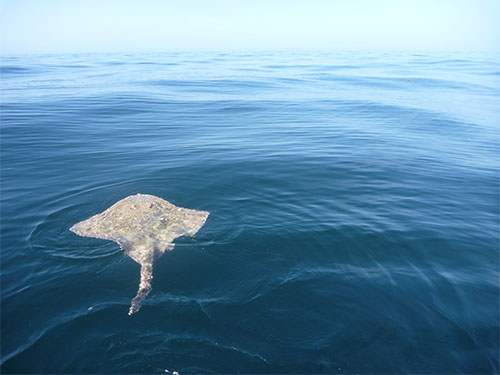Fishery
Fishery
Skates are taken as a bycatch in bottom trawl fisheries, which may seasonally target skates. They are also a target species or bycatch in gill net, tangle net and long-line fisheries. Elasmobranchs have life-history characteristics that make them vulnerable to overfishing, including slow growth, late age at maturity and low fecundity, making them less resilient than bony fishes to overexploitation. Skates have been commercially exploited in Europe for hundreds of years, but in 2009 it became “prohibited for EU vessels to target, retain, tranship or land” certain species in some ICES areas, including the critically endangered common skate and the endangered white skate. Since 2009 skates must also be landed by species, rather than grouped as skates and rays.
Species Ecology
Species Ecology
Skates are related to sharks and have cartilaginous skeletons, but skates have a flat body shape with pectoral fins along the length of their body. Their mouths and gill slits are positioned on the underside of their body, but they have dorsal spiracles so that the skate can breathe whilst buried in sediment. Most of the species fished in the UK are part of the skate family, though their common names confusingly suggest they are rays. There are 16 principal species of skate in the UK and species such as the thornback ray and spotted ray are in the skate family.
 There are several features that distinguish a skate from a ray. Skates have a first and second dorsal fin and pelvic fin of a skate is bilobed. These bilobed pelvic fins allow the skate to ‘walk’ along the seabed. Other distinctions between skates and rays are that skates have a weak electric discharge organ, likely used for communication and they also lay eggs often called mermaids purses. The thornback ray for example can lay up to 150 eggs per year.
There are several features that distinguish a skate from a ray. Skates have a first and second dorsal fin and pelvic fin of a skate is bilobed. These bilobed pelvic fins allow the skate to ‘walk’ along the seabed. Other distinctions between skates and rays are that skates have a weak electric discharge organ, likely used for communication and they also lay eggs often called mermaids purses. The thornback ray for example can lay up to 150 eggs per year.
Most skates feed on bottom dwelling animals, such as shrimp, crab, oyster, clams, and other invertebrates and also fish such as sand eels. To feed on these animals they have grinding plates in their mouths.
There are differences in the body size of each species. The smaller species such as spotted ray and cuckoo ray grow to about 70–80cm in length while the thornback ray and blonde ray grow to 110– 120cm and the common skate grows to more than 200cm. The smaller species mature at an earlier age than the large species. Male can be identified by a pair of claspers alongside the pelvic fins.